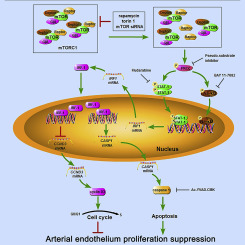当前位置:
X-MOL 学术
›
J. Mol. Cell. Cardiol.
›
论文详情
Our official English website, www.x-mol.net, welcomes your
feedback! (Note: you will need to create a separate account there.)
IRF-1 mediates the suppressive effects of mTOR inhibition on arterial endothelium.
Journal of Molecular and Cellular Cardiology ( IF 4.9 ) Pub Date : 2020-02-19 , DOI: 10.1016/j.yjmcc.2020.02.006 Kai Peng 1 , Xing Fan 1 , Qiannan Li 1 , Yiying Wang 1 , Xiaolin Chen 1 , Pingxi Xiao 2 , Anthony G Passerini 3 , Scott I Simon 3 , ChongXiu Sun 1
Journal of Molecular and Cellular Cardiology ( IF 4.9 ) Pub Date : 2020-02-19 , DOI: 10.1016/j.yjmcc.2020.02.006 Kai Peng 1 , Xing Fan 1 , Qiannan Li 1 , Yiying Wang 1 , Xiaolin Chen 1 , Pingxi Xiao 2 , Anthony G Passerini 3 , Scott I Simon 3 , ChongXiu Sun 1
Affiliation

|
AIMS
Mammalian target of rapamycin (mTOR) inhibitors used in drug-eluting stents (DES) to control restenosis have been found to delay endothelialization and increase incidence of late-stent thrombosis through mechanisms not completely understood. We revealed that mTOR inhibition (mTORi) upregulated the expression of cell growth suppressor IRF-1 in primary human arterial endothelial cells (HAEC). This study aimed to examine how mTOR-regulated IRF-1 expression contributes to the suppressive effect of mTORi on arterial endothelial proliferation.
METHODS AND RESULTS
Western blotting, quantitative PCR, and a dual-luciferase reporter assay indicated that mTOR inhibitors rapamycin and torin 1 upregulated IRF-1 expression and increased its transcriptional activity. IRF-1 in turn contributed to the suppressive effect of mTORi by mediating HAEC apoptosis and cell cycle arrest in part through upregulation of caspase 1 and downregulation of cyclin D3, as revealed by CCK-8 assay, Annexin V binding assay, measurement of activated caspase 3, BrdU incorporation assay, and matrigel tube formation assay. In a mouse model of femoral artery wire injury, administration of rapamycin inhibited EC recovery, an effect alleviated by EC deficiency of IRF-1. Chromatin immunoprecipitation assay with HAEC and rescue expression of wild type or dominant-negative IRF-1 in EC isolated from Irf1-/- mice confirmed transcriptional regulation of IRF-1 on the expression of CASP1 and CCND3. Furthermore, mTORi activated multiple PKC members, among which PKCζ was responsible for the growth-inhibitory effect on HAEC. Activated PKCζ increased IRF1 transcription through JAK/STAT-1 and NF-κB signaling. Finally, overexpression of wild type or mutant raptor incapable of binding mTOR indicated that mTOR-free raptor contributed to PKCζ activation in mTOR-inhibited HAEC.
CONCLUSIONS
The study reveals an IRF-1-mediated mechanism that contributes to the suppressive effects of mTORi on HAEC proliferation. Further study may facilitate the development of effective strategies to reduce the side effects of DES used in coronary interventions.
中文翻译:

IRF-1介导mTOR抑制对动脉内皮的抑制作用。
已发现用于药物洗脱支架(DES)的AIMS哺乳动物雷帕霉素(mTOR)抑制剂的靶标可通过尚未完全了解的机制延迟内皮化并增加晚期支架血栓形成的发生率。我们发现,mTOR抑制(mTORi)上调了人类原发性动脉内皮细胞(HAEC)中细胞生长抑制剂IRF-1的表达。这项研究旨在检查mTOR调节的IRF-1表达如何有助于mTORi对动脉内皮增殖的抑制作用。方法和结果Western印迹,定量PCR和双荧光素酶报告基因检测表明mTOR抑制剂雷帕霉素和torin 1上调IRF-1表达并增加其转录活性。IRF-1反过来通过介导HAEC凋亡和细胞周期停滞而部分介导caspase 1的上调和cyclin D3的下调来促进mTORi的抑制作用,如CCK-8测定,膜联蛋白V结合测定,活化caspase的测定所揭示3,BrdU掺入法和基质胶管形成法。在股动脉钢丝损伤的小鼠模型中,雷帕霉素的给药抑制了EC的恢复,这一作用可通过IRF-1的EC缺乏得到缓解。用HAEC进行染色质免疫沉淀测定,并在从Irf1-/-小鼠分离的EC中抢救野生型或显性负IRF-1的表达,证实了IRF-1对CASP1和CCND3表达的转录调控。此外,mTORi激活了多个PKC成员,其中PKCζ对HAEC的生长具有抑制作用。活化的PKCζ通过JAK / STAT-1和NF-κB信号传导增加IRF1转录。最后,不能与mTOR结合的野生型或突变型猛禽的过表达表明无mTOR的猛禽有助于mTOR抑制的HAEC中PKCζ的活化。结论该研究揭示了IRF-1介导的机制,其有助于mTORi对HAEC增殖的抑制作用。进一步的研究可能有助于开发减少冠状动脉介入治疗所用DES副作用的有效策略。结论该研究揭示了IRF-1介导的机制,其有助于mTORi对HAEC增殖的抑制作用。进一步的研究可能有助于开发减少冠状动脉介入治疗所用DES副作用的有效策略。结论该研究揭示了IRF-1介导的机制,其有助于mTORi对HAEC增殖的抑制作用。进一步的研究可能有助于开发减少冠状动脉介入治疗所用DES副作用的有效策略。
更新日期:2020-02-20
中文翻译:

IRF-1介导mTOR抑制对动脉内皮的抑制作用。
已发现用于药物洗脱支架(DES)的AIMS哺乳动物雷帕霉素(mTOR)抑制剂的靶标可通过尚未完全了解的机制延迟内皮化并增加晚期支架血栓形成的发生率。我们发现,mTOR抑制(mTORi)上调了人类原发性动脉内皮细胞(HAEC)中细胞生长抑制剂IRF-1的表达。这项研究旨在检查mTOR调节的IRF-1表达如何有助于mTORi对动脉内皮增殖的抑制作用。方法和结果Western印迹,定量PCR和双荧光素酶报告基因检测表明mTOR抑制剂雷帕霉素和torin 1上调IRF-1表达并增加其转录活性。IRF-1反过来通过介导HAEC凋亡和细胞周期停滞而部分介导caspase 1的上调和cyclin D3的下调来促进mTORi的抑制作用,如CCK-8测定,膜联蛋白V结合测定,活化caspase的测定所揭示3,BrdU掺入法和基质胶管形成法。在股动脉钢丝损伤的小鼠模型中,雷帕霉素的给药抑制了EC的恢复,这一作用可通过IRF-1的EC缺乏得到缓解。用HAEC进行染色质免疫沉淀测定,并在从Irf1-/-小鼠分离的EC中抢救野生型或显性负IRF-1的表达,证实了IRF-1对CASP1和CCND3表达的转录调控。此外,mTORi激活了多个PKC成员,其中PKCζ对HAEC的生长具有抑制作用。活化的PKCζ通过JAK / STAT-1和NF-κB信号传导增加IRF1转录。最后,不能与mTOR结合的野生型或突变型猛禽的过表达表明无mTOR的猛禽有助于mTOR抑制的HAEC中PKCζ的活化。结论该研究揭示了IRF-1介导的机制,其有助于mTORi对HAEC增殖的抑制作用。进一步的研究可能有助于开发减少冠状动脉介入治疗所用DES副作用的有效策略。结论该研究揭示了IRF-1介导的机制,其有助于mTORi对HAEC增殖的抑制作用。进一步的研究可能有助于开发减少冠状动脉介入治疗所用DES副作用的有效策略。结论该研究揭示了IRF-1介导的机制,其有助于mTORi对HAEC增殖的抑制作用。进一步的研究可能有助于开发减少冠状动脉介入治疗所用DES副作用的有效策略。









































 京公网安备 11010802027423号
京公网安备 11010802027423号